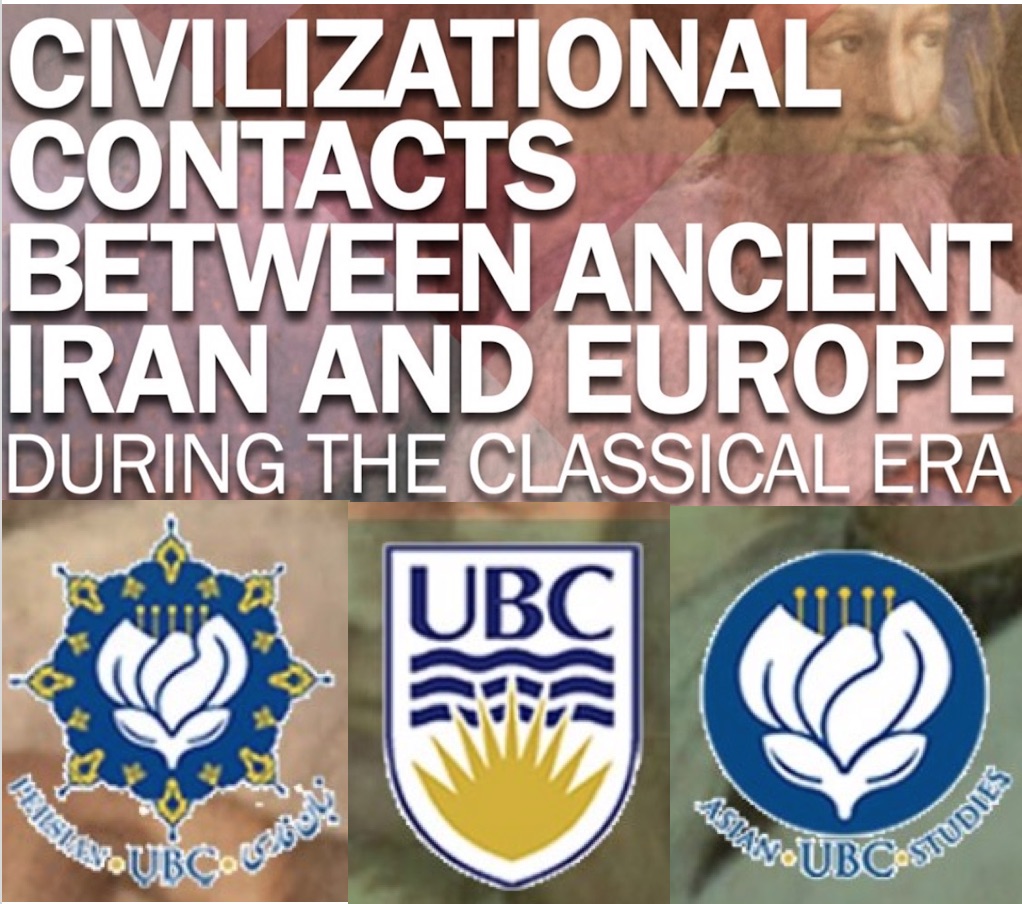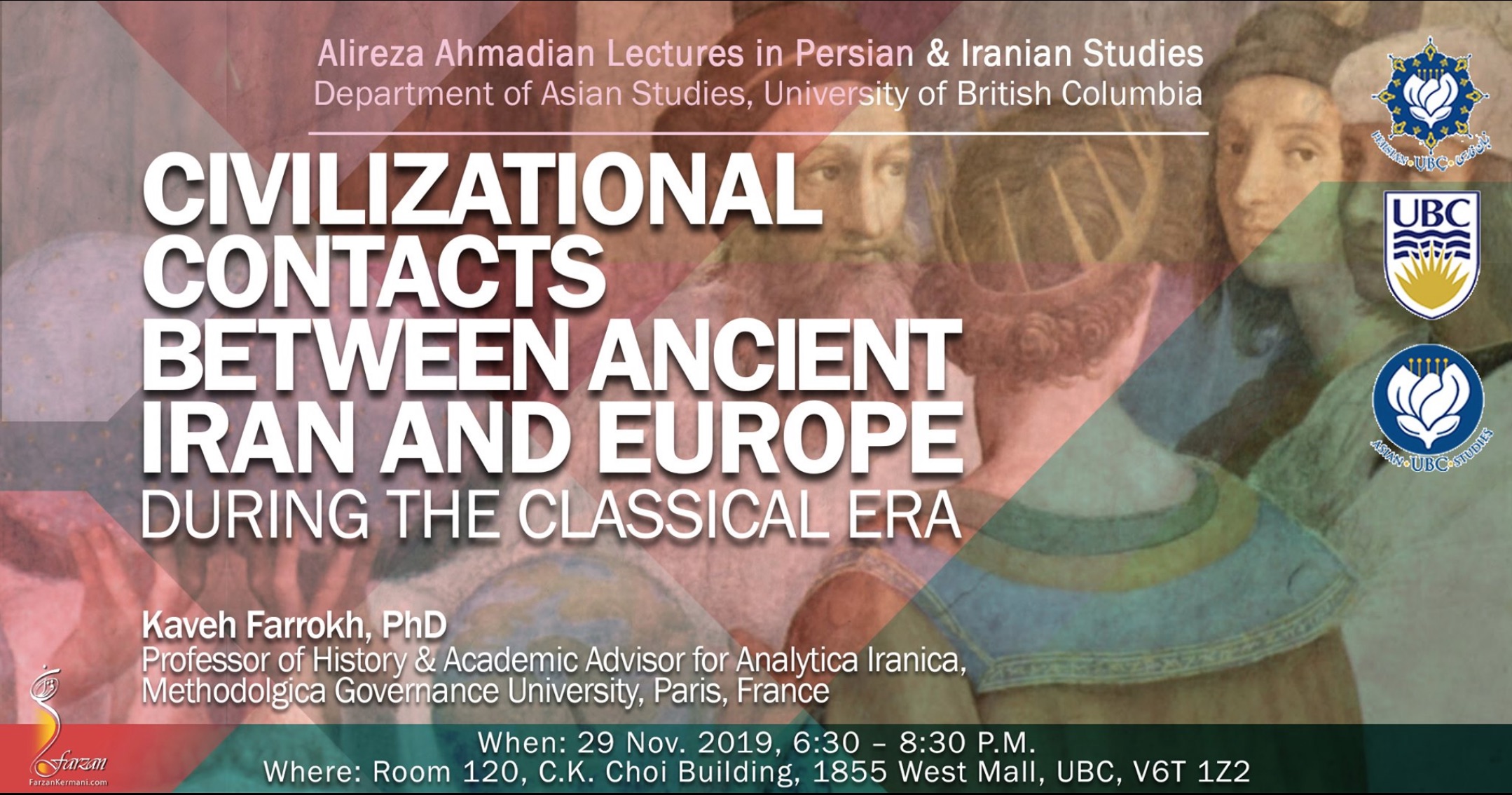Kaveh Farrokh will be providing a comprehensive lecture on November 29, 2019 at the University of British Columbia:
“Civilizational Contacts between Ancient Iran and Europe”
Lecture Time & Location: 29 November 2019 6:30-8:30 pm – Room 120, CK Choi Building – For details view below poster – and also click here …). The lecture is free, however due to limited seating interested participants are encouraged to obtain their (Free) tickets (for details view below poster – and also click here …)
This lecture will be hosted by the Alireza Ahmadian Lectures in Persian and Iranian Studies, Persian Language and Iranian Studies Initiative at UBC (University of British Columbia), UBC Asian Studies, UBC Persian Club and the UBC Zoroastrian Student Association.
Abstract & Overview of Lecture
This lecture provides a synoptic overview of the civilizational relations between Greater ancient Iran and Europa (Greco-Roman civilization as well continental Europe). The discussion is initiated with an examination of the conduits of exchange between Greater ancient Iran (the Achaemenid, Parthian and Sassanian dynasties of Iran as well as the role of Northern Iranian peoples), the Caucasus and Europa. The lecture then provides an overview of learning exchanges between east and west spanning the time era from the Achaemenids into the Post-Sassanian eras, followed by examples of artistic, architectural, and engineering exchanges between Greco-Roman and Iranian civilizations. Select examples of the ancient Iranian legacy influence upon the European continent are also discussed, followed (time permitting) by examples of the musical legacy of ancient Iran as well as Iranian-European exchanges in the culinary domain.
Select References & Readings
Ahmed, A. & Zaman, O. (eds.) (2018). Dialogue Between Cultures & Exchange of Knowledge And Cultural Ideas between Iran, Turkey & Central Asia With Special reference to the Sasanian & Gupta Dynasty, Proceedings of Conference 8-10 February, 2018. Assam, India: Department of Persian Guawahati University.
Akhvledinai & Khimshiasvili, (2003). Impact of the Achaemenian architecture on Iberian kingdom: Fourth-first centuries BC. The First International Conference on the Ancient Cultural Relations Between Iran and Western Asia, Abstracts of Papers, Tehran, Iran, August 16-18, 2003, Tehran: Iran Cultural Fairs Institute.
Angelakis, A.N., Mays, L.W., Koutsoyiannis, D., Mamassis, N. (2012). Evolution of Water Supply through the Millennia. London & New York: IWA Publishing.
Asutay-Effenberger, N. & Daim, F. (eds.) (2019). Sasanidische Spuren in der Byzantinischen, Kaukasischen und Islamischen Kunst und Kultur [Sasanian Elements in Byzantine, Caucasian and Islamic Art and Culture]. Mainz, Germany: Verlag des Römisch-Germanischen Zentralmuseums.
Azarpay, G. (2000). Sasanian art beyond the Persian world. In Mesopotamia and Iran in the Parthian and Sasanian periods: Rejection and Revival c.238 BC-AD 642, Proceedings of a Seminar in memory of Vladimir G. Lukonin (ed. J. Curtis), London: British Museum Press, pp.67-75.
Azkaei, P.S. (1383/2004). حکیم رازی (حکمت طبیعی و نظام فلسفی) [(The) Wise Razi (Natural Wisdom and System of Philosophy)]. Tehran, Iran. Entesharate Tarh-e Now.
Babaev, I., Gagoshidze, I., & Knauß, F. S. (2007). An Achaemenid “Palace” at Qarajamirli (Azerbaijan) Preliminary Report on the Excavations in 2006. Ancient Civilizations from Scythia to Siberia, Volume 13, Numbers 1-2, pp. 31-45.
Beckwith C.I. (2011). Empires of the Silk Road: A History of Central Asia from the Bronze Age to the Present. Princeton University Press.
Canepa, M. P. (2010). Distant displays of power: understanding cross-cultural interaction interaction among the elites of Rome, Sasanian Iran and Sui-Tang China. Ars Orientalis, Vol. 38, Theorizing Cross-Cultural Interaction among the Ancient and Early Medieval Mediterranean, Near East and Asia, pp. 121-154.
Carduso, E.R.F. (2015). Diplomacy and oriental influence in the court of Cordoba (9th to 10th centuries). Dissertation, Department of History of Islamic Mediterranean Societies, University of Lisbon, Portugal.
Compareti, M. (2019). Assimilation and Adaptation of Foreign Elements in Late Sasanian Rock Reliefs at Taq-i Bustan. In Sasanidische Spuren in der Byzantinischen, Kaukasischen und Islamischen Kunst und Kultur [Sasanian Elements in Byzantine, Caucasian and Islamic Art and Culture] (eds. N. Asutay-Effenberger & F. Daim), Mainz, Germany: Verlag des Römisch-Germanischen Zentralmuseums, pp.19-36.
Curatola, G., & Scarcia, G. (Tr. M. Shore, 2007). The Art and Architecture of Persia. New York: Abbeville Press.
During J., Mirabdolbaghi, Z., & Safvat, D. (1991). The Art of Persian Music. Mage Publishers.
Farhat, H. (2004). The Dastgah Concept in Persian Music. Cambridge & New York: Cambridge University Press.
Farrokh, K. (2018). Germania, Vikings, Saxons and Ancient Iran. Persian Heritage, 90, pp.28-30.
Farrokh, K. (2007). Shadows in the Desert: Ancient Persia at War. Oxford: Osprey Publishing-Персы: Армия великих царей-سایههای صحرا/کویر (انتشارات ققنوس ۱۳۹۰ و انتشارات طاق بستان ۱۳۹۰) – see Book review from peer-reviewed Iranshenasi Journal
Feltham, H. (2010). Lions, Silks and Silver: the Influence of Sassanian Persia. Sino-Platonic Papers, 206, pp. 1-51.
Freely, J. (2009). Aladdin’s Lamp: How Greek Science Came to Europe Through the Islamic World. New York: Alfred A. Knopf.
Gagoshidze, Y. M. (1992). The Temples at Dedoplis Mindori. East and West, 42, pp. 27-48.
Garsoïan, N. (1985). Byzantium and the Sassanians. In The Cambridge History of Iran Volume 3: The Seleucid, Parthian and Sasanid Periods, Part 1 (ed. E. Yarshater), Cambridge, England: Cambridge University Press, pp. 568-592.
Gheverghese, J.G. (1991). The Crest of the Peacock: Non-European Roots of Mathematics. London: I.B. Tauris.
Gnoli, G. & Panaino, A. (eds.) (2009). Studies in History of Mathematics, Astronomy and Astrology in Memory of David Pingree – Serie Orientale Roma CII. Rome: Italy: Istituto Italiano per L’Africa e L’Oriente.
Kayser, P., & Waringo, G. (2003). L’aqueduc souterrain des Raschpëtzer: un monument Antique de l’art de l’ingénieur au Luxembourg [The underground aqueduct of Raschpëtzer: an ancient monument of the art of engineering in Luxembourg]. Revue Archéologique de l’Est, vol. 52, pp. 429-444.
Kurz, O. (1985). Cultural relations between Parthia and Rome. In The Cambridge History of Iran Volume 3: The Seleucid, Parthian and Sasanid Periods, Part 1 (ed. E. Yarshater), Cambridge, England: Cambridge University Press, pp. 559-567.
Miller, A.C. (2006). Jundi-Shapur, bimaristans, and the rise of academic medical centres. Journal of the Royal Society of Medicine, 99 (12), pp. 615–617.
Miller, L.C. (1999). Music and Song in Persia (RLE Iran B): The Art of Avaz. Great Britain: Routledge.
Overlaet, B. (2018). Sasanian, Central Asian and Byzantine Iconography – Patterned Silks and Cross-Cultural Exchange. In B. Bühler & V. Freiberger (eds.), Der Goldschatz von Sânnicolau Mare [The Gold Treasure of Sânnicolau Mare]. Regensburg: Schnell & Steiner, pp. 139-152.
Roberts, A.M. (2013). The Crossing Paths of Greek and Persian Knowledge in the 9th-century Arabic ‘Book of Degrees’. Orientalia Christiana Analecta, 293, pp.279-303.
Silva, J.A.M. (2019). The Influence of Gondeshapur Medicine during the Sassanid Dynasty and the Early Islamic Period. Archives of Iranian Medicine, 22 (9), pp. 531-540.
Sparati N. (2002). L’ enigma delle arti Asittite della Calabria Ultra-Mediterranea [The enigma of the Asittite arts of Calabria Ultra-Mediterranean]. Mammola, Italy: MuSaBa – Santa Barbera Art Foundation & Iiriti Editore.
Ward. P. (1968). The Origin and Spread of Qanats in the Old World. Proceedings of the American Philosophical Society, Vol. 112, No. 3, pp. 170-181.
Wulff, H. (1968). The Qanats of Iran. Scientific American, Vol. 218, No. 4, pp. 94–105.
Select Major Reference Resources in Kaveh Farrokh.com
- Europa and Eire-An (Ancient Iran/Persia)
- Learning, Science, Knowledge, Technology & Medicine
- Achaemenid Era
- Parthian Era & Pontus-Cappadocia
- Sassanian Era
- Culture, Mythology & Nowruz
Select Articles in Kavehfarrokh.com
- Persian Influence on Greek Thought
- Persian influence on Greece
- When Roman “Barbarians” Met the Asian Enlightenment
- Dome Architecture and Europe
- Castle of Ardashir and Rome’s Basilica di Massenzio
- Norwegian Vikings purchased Silk from Persia
- The Viking Ulfbehrt Sword and Persian Steel
- Viking-era Sasanian and Arab-Sasanian Silver Coins Found in Sweden
- Rumanian Scholar’s views of Ancient Europa-Iran Ties
- Mithraism
- Brief Notes on Spoons and Forks in Greco-Roman and Ancient Iranian Civilizations
- The Windmill and the contribution of Persia
- GONDÊŠÂPUR History & Medical School
- Ibn Sina, Persian Polymath and Physician, Never Demanded Money from his Patients





